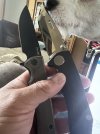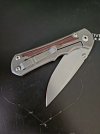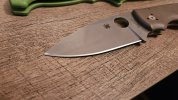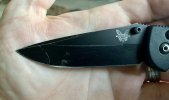-
The BladeForums.com 2024 Traditional Knife is available! Price is $250 ea (shipped within CONUS).
Order here: https://www.bladeforums.com/help/2024-traditional/
You are using an out of date browser. It may not display this or other websites correctly.
You should upgrade or use an alternative browser.
You should upgrade or use an alternative browser.
What Did You Sharpen Today?
- Thread starter kreisler
- Start date


Fox Baby Core, 2.125" N690Co "big belly" blade. I had subjected the factory edge to some deliberately hard use, and it held up about as one would expect from a $100US knife. It was still fairly sharp, but I intended to give it a minor re-profile and see how it would do at about 17 degrees with a little polish.
The cheap allegedley natural Japanese "stone" in the rear was gritty and as loose as a waterstone, and while it cut fast, it may have left a few micro-chips behind. I will relegate that stone to garden tools, it is not fit for a decent pocketknife.
The hard Ark in the rear was not up to sharpening this steel. Wrong tool for this steel.
I finally got acceptable performance with the Shapton glass stones at 500 and 1K. They handled the steel easily, but my imperfect technique causes the blade to bite those stones on occasion, and they seem to clog fast. I have decided I don't really care for them. I was popping hairs behind the 1K, and got an even, frosty scratch pattern.
I went to the black Ark next. This stone doesn't have the 3D appearance of the better black Arks, but it performed very well. It refined the edge, got the blade shaving reliably, and left a very fine scratch pattern. I wasn't sure what to expect after the hard Ark couldn't cut it, but this black Ark did a decent job on the scratches left behind by the 1K JIS ceramic Shapton.
All the stones were lubed with bottled water with a couple of drops of lanolin. I use the cheap rust eraser to clean up the stones.
I finished with 3 micron diamond polishing compound on leather. Another noticeable boost in smooth shaving power, and a brilliant gleam.
The last two stages were not important for a working blade, but they improved the performance on paper and hair significantly. I didn't bother putting a mirror finish on this $100 pocket knife, as I intend to use it a lot on hard cutting tasks and it still has a few deep scratches from the factory job. Maybe someday after those scratches are sharpened away I will put it on the Wicked Edge and get a mirror finish.
My impression is that this steel is not particularly easy to sharpen. I started with the softer natural stones to see if they were suitable and decided with my limited skills and natural stones I was wasting time and screwing up my stones! This blade seems to need at least ceramic stones to do anything beyond a quick touch-up of an already-sharp knife. Diamonds or CBN for me, others may be able to get better results with natural stones but I am not there yet!
I really like this little guy and its M390/carbon fiber uptown brother. I would prefer a more straight blade, a much smaller choil, and no flipper tab, but otherwise it is a comfortable carry and a good worker!
Last edited:
- Joined
- Jan 14, 2023
- Messages
- 4,942
Had to sharpen out a rock chip on my S45VN Inkosi Insingo today. First time working with this steel and was pleasantly surprised how easily the sharpmaker fixed this edge.
Looking forward to Magnacut after hearing all the rave reviews but I’m not in a real hurry as the 45 is very nice.
Looking forward to Magnacut after hearing all the rave reviews but I’m not in a real hurry as the 45 is very nice.
- Joined
- Apr 22, 2011
- Messages
- 162
I'm really into french pocket knives lately... Today a Le liadou du vallon in 14c28n steel with juniper wood handles arrived. It's my first knife with juniper wood and I already love the peppery smell.
The factory edge wasn't too great so I went to sharpening it right away. I used my 400 and 3000 grit vitrified diamond stones and after that stropped with 4-6micron on leather, then 1 micron on leather and finished with 0.25 micron on leather.

The factory edge wasn't too great so I went to sharpening it right away. I used my 400 and 3000 grit vitrified diamond stones and after that stropped with 4-6micron on leather, then 1 micron on leather and finished with 0.25 micron on leather.

- Joined
- Aug 11, 2021
- Messages
- 1,428
I really wanna get one of those bess scales.I'm really into french pocket knives lately... Today a Le liadou du vallon in 14c28n steel with juniper wood handles arrived. It's my first knife with juniper wood and I already love the peppery smell.
The factory edge wasn't too great so I went to sharpening it right away. I used my 400 and 3000 grit vitrified diamond stones and after that stropped with 4-6micron on leather, then 1 micron on leather and finished with 0.25 micron on leather.


This is a new Benchmade mini Osborne, #945? with S30V steel. I put Flytanium copper scales and a blue deep carry pocket clip on it, but that didn't correct the stupid recurve in the blade! There was a slight burr on one side as well. That's all the excuse I needed!
I lubed an Atoma 400 with a little diluted Krud Kutter. Then I respectfully worked the recurved section of the blade over the stone until I had the choil area relieved enough to get the whole blade on a flat stone. The Krud Kutter dissolves sharpie ink immediately, so I used a 15X loupe and watched the scratch patterns to track my progress.
Once the recurve and coarse factory scratches were gone, I finished up with an Atoma 600. I used as little pressure as I could on the last strokes to see how fine I could get the bevels. No stropping, as I wanted to check the cutting power at 600. Period!
It is popping hairs reliably and cutting fine paper smoothly and cleanly. An excellent compromise between aggression and love, ugliness and beauty, pizza or a chimichanga. I am beginning to wonder why I typically tack on two or three more finishing stages, especially when I am not intending to get a mirror finish.
The minor reprofiling went very easily on a fairly new Atoma 400. You can feel the tiny swarf channels in this stone, but they don't take long to get used to. The transition to the Atoma 600 was complete in 5 or 10 strokes per side, tops. The 600 stone feels a lot smoother, almost like a more coarse natural stone. It cuts fast and leaves a smooth surface behind, looking a little like a hard Arkansas stone. Very good tools.
Krud Kutter solution is an outstanding lubricant for the diamond stones. Absolutely no clogging and the stones (and everything else) wipe clean instantly.
Since I am lubing with water, I rinse the pivot area with WD-40 and then lube seperately. Displace the water, then replace the lube and rust preventative.
This is a sexy little knife. A little heavy with the copper scales, but television commercials have taught me that touching copper will help me to live forever, so how can I resist?!?! I may have let my inner New Orleans pimp go a little too far with the blue pocket clip.
Last edited:
- Joined
- Mar 3, 2022
- Messages
- 360
Spats McGee
Gold Member
- Joined
- Jun 6, 2019
- Messages
- 395
No pics today, but I touched up one id Mrs. McGee’s kitchen knives and put a whole new edge on a Buck lockback.
- Joined
- Sep 13, 2017
- Messages
- 9,113
One of my favorite threads.
Well done everyone!
Well done everyone!
- Joined
- Dec 10, 2021
- Messages
- 445
I bought this at the same time as my first Manix when I was on my journey of finding a new EDC. (SOG has never been used)
There was a recurve on this blade. Ground off 0.145g of steel with the 600 grit to even it out.

600, 1200, 6um, 1um, 0.25um, 0.1um
BESS tested at 43 and 51. Test points were a few mm apart.
There was a recurve on this blade. Ground off 0.145g of steel with the 600 grit to even it out.

600, 1200, 6um, 1um, 0.25um, 0.1um
BESS tested at 43 and 51. Test points were a few mm apart.
- Joined
- Aug 11, 2021
- Messages
- 1,428
I need to get a bess scale. Id love to play with one sometime.I bought this at the same time as my first Manix when I was on my journey of finding a new EDC. (SOG has never been used)
There was a recurve on this blade. Ground off 0.145g of steel with the 600 grit to even it out.
600, 1200, 6um, 1um, 0.25um, 0.1um
BESS tested at 43 and 51. Test points were a few mm apart.
- Joined
- Dec 10, 2021
- Messages
- 445
- Joined
- Dec 10, 2021
- Messages
- 445
BESS tests were off. Line was too tight. I had not used it in several days and forgot how much tension to apply.
Marked a spot at just before the curve in the blade.
Test clip = 56
Test clip = 56
Canister = 58
Marked a spot at just before the curve in the blade.
Test clip = 56
Test clip = 56
Canister = 58
Kitchen Knife Sharpening Day


I went through the knife block this morning and pulled out the 7" Santoku (Miyabi Artisan's MC63 steel, 66HRC per Miyabi), an Enso paring knife (SG2, 63HRC), and three steak knives (Berkel X50CrMoV15, max 56 HRC, a mid-line German stainless). These knives would no longer cut paper smoothly enough for my taste, even after regular honing with a Messermeister 12" ceramic hone.
I broke out a well-used but flat and sharp hard Arkansas stone, 8x2x1", and sprayed it with spring water with a couple of drops of lanolin. The steak knives were up first. They got hair-popping sharp at about 20 dps very quickly, and they got very smooth with light pressure on the last few strokes.
I noticed a few tiny chips on all three edges, but I decided not to grind them away. They are steak knives and they have a hard life, cutting on glass and ceramic surfaces. Steak or any fibrous materials will not mind the tiny chips. I might have tried a soft Ark if I were going to remove much more steel.
I resisted the urge to finish any further. They will cut paper smoothly and pop hair without going any finer, and they will cut steak like a machete or chainsaw, ruthlessly and without mercy. I pity the fool who shows up at my house with his own steak knife! I'm going to embarass that boy!
Time to move on to the Japanese blades, of more upscale steel. I was not sure what to expect from the hard Ark, but I like the idea of using natural stones if the steel will cooperate. I find using natural stones to be romantic and spiritually fulfilling, as opposed to the industrial feeling I get from sharpening with industrial diamonds. Others may have a less colorful reaction to the tool used, and maybe I am taking it too seriously! Or not seriously enough!
I used about 15-17 dps, as a concession to my wife. She is careful with the knives, but she is an enthusiastic cook and I expect things to get banged around a little. It gives me an excuse to sharpen!
Both the MC63 and SG2 blades responded to the hard Ark very well for a touch-up of a still fairly sharp edge. They cut like beavers after ten or twelve strokes per side, with the pressure decreasing to "as light as made sense." Food sharp, very quickly. I don't know how well this stone would handle removing more metal, but for this task it was clearly capable, I wasn't pushing it too far and getting any glazing or excess wear, and I got sharp with the minimum number of strokes.
I stropped about four or five strokes per side on the Herald Solingen red on leather. That big red strop just kills, the little HS crayons leave a beautiful finish, and they last a long time. No problem with the price after charging several strops and observing the performance, how long they go between charges, and how much is still left. I stopped here, even though the black HS strop was within my lunging distance. I think I have gotten way out of control with polishing edges that probably perform better if left less polished. I might be learning!
Those thin Asian style blades glide through food. They are champs at paper and hair, but a lot of blades can do that. Cutting up both hard and soft things with the same blade, using no effort, the blade always going exactly where you want it, those things are super for food preparation! And the food has to taste better, and it has to be more healthy, more nutricious. Food prepared with a very sharp knife is going to be better in every way, period.
Here are the tools I used. An ebay used hard Arkansas 8x2x1 stone on the common stone holder, and a piece of broken hard Ark to keep the surface clean and sharp. A leather strop lathered up with Herald Solingen red crayon. A 10 or 15X loupe, I can't remember which, a roll of receipt paper, a spray bottle loaded with bottled water (because the tap water here has about 125 tds) and a few drops of lanolin, and a bristle brush to clean up.

Not pictured is the comfortable chair, a bucket of water, and an old bathtowel I keep draped over a shoulder to dry things off. I didn't think a picture of the chair and/or towel would be helpful to forum members. A bold decision, but I've seen the towel, I know what it looks like, who else would care?
This gear was very reasonably priced, only about $125, although I probably got lucky with the used stone. It was flat enough and not saturated with oil, so I flattened one side with an Atoma 140 I use it all the time on quick and dirty jobs like this. It produces a beautiful edge on the right steel. I've put D2 and some of the more modern steels on it and all it will do is shine the surface a little! "Great on most of the old classics!!! No no no with super steel!"


I went through the knife block this morning and pulled out the 7" Santoku (Miyabi Artisan's MC63 steel, 66HRC per Miyabi), an Enso paring knife (SG2, 63HRC), and three steak knives (Berkel X50CrMoV15, max 56 HRC, a mid-line German stainless). These knives would no longer cut paper smoothly enough for my taste, even after regular honing with a Messermeister 12" ceramic hone.
I broke out a well-used but flat and sharp hard Arkansas stone, 8x2x1", and sprayed it with spring water with a couple of drops of lanolin. The steak knives were up first. They got hair-popping sharp at about 20 dps very quickly, and they got very smooth with light pressure on the last few strokes.
I noticed a few tiny chips on all three edges, but I decided not to grind them away. They are steak knives and they have a hard life, cutting on glass and ceramic surfaces. Steak or any fibrous materials will not mind the tiny chips. I might have tried a soft Ark if I were going to remove much more steel.
I resisted the urge to finish any further. They will cut paper smoothly and pop hair without going any finer, and they will cut steak like a machete or chainsaw, ruthlessly and without mercy. I pity the fool who shows up at my house with his own steak knife! I'm going to embarass that boy!
Time to move on to the Japanese blades, of more upscale steel. I was not sure what to expect from the hard Ark, but I like the idea of using natural stones if the steel will cooperate. I find using natural stones to be romantic and spiritually fulfilling, as opposed to the industrial feeling I get from sharpening with industrial diamonds. Others may have a less colorful reaction to the tool used, and maybe I am taking it too seriously! Or not seriously enough!
I used about 15-17 dps, as a concession to my wife. She is careful with the knives, but she is an enthusiastic cook and I expect things to get banged around a little. It gives me an excuse to sharpen!
Both the MC63 and SG2 blades responded to the hard Ark very well for a touch-up of a still fairly sharp edge. They cut like beavers after ten or twelve strokes per side, with the pressure decreasing to "as light as made sense." Food sharp, very quickly. I don't know how well this stone would handle removing more metal, but for this task it was clearly capable, I wasn't pushing it too far and getting any glazing or excess wear, and I got sharp with the minimum number of strokes.
I stropped about four or five strokes per side on the Herald Solingen red on leather. That big red strop just kills, the little HS crayons leave a beautiful finish, and they last a long time. No problem with the price after charging several strops and observing the performance, how long they go between charges, and how much is still left. I stopped here, even though the black HS strop was within my lunging distance. I think I have gotten way out of control with polishing edges that probably perform better if left less polished. I might be learning!
Those thin Asian style blades glide through food. They are champs at paper and hair, but a lot of blades can do that. Cutting up both hard and soft things with the same blade, using no effort, the blade always going exactly where you want it, those things are super for food preparation! And the food has to taste better, and it has to be more healthy, more nutricious. Food prepared with a very sharp knife is going to be better in every way, period.
Here are the tools I used. An ebay used hard Arkansas 8x2x1 stone on the common stone holder, and a piece of broken hard Ark to keep the surface clean and sharp. A leather strop lathered up with Herald Solingen red crayon. A 10 or 15X loupe, I can't remember which, a roll of receipt paper, a spray bottle loaded with bottled water (because the tap water here has about 125 tds) and a few drops of lanolin, and a bristle brush to clean up.

Not pictured is the comfortable chair, a bucket of water, and an old bathtowel I keep draped over a shoulder to dry things off. I didn't think a picture of the chair and/or towel would be helpful to forum members. A bold decision, but I've seen the towel, I know what it looks like, who else would care?
This gear was very reasonably priced, only about $125, although I probably got lucky with the used stone. It was flat enough and not saturated with oil, so I flattened one side with an Atoma 140 I use it all the time on quick and dirty jobs like this. It produces a beautiful edge on the right steel. I've put D2 and some of the more modern steels on it and all it will do is shine the surface a little! "Great on most of the old classics!!! No no no with super steel!"
Last edited:








